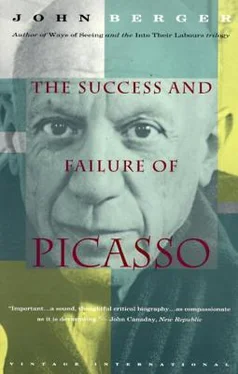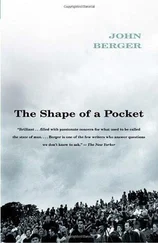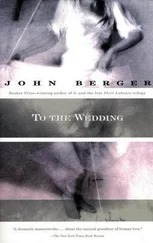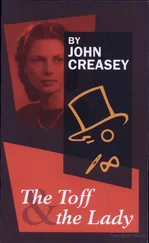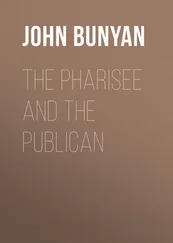However, to pursue this point further now would take us too far from our immediate purpose. What we need to understand is the promise originally offered by Cubism. What could its painters hope to achieve?
They hoped to achieve a truly modern art, an art that belonged to the new century. Apollinaire expressed this many times:
…we who are constantly fighting along the frontiers of the infinite and of the future.
This sense of modernity was expressed in Cubist paintings in several different ways.
1. By the choice of subject. The subjects were taken from everyday life in a modern city. But, unlike the Impressionists, the Cubists seldom painted natural ‘sights’ — the Seine, parks, gardens. The one monument that appealed to them was the Eiffel Tower. They were interested in constructions and in the man-made. Mostly they painted what was to hand — in the literal sense of the term: café tables, cheap chairs, coffee cups, newspapers, carafes, soda-syphons, ash-trays, wash-stands, letters. In their choice of objects they emphasized the ordinariness of their possessions. This ordinariness was of a new kind, because it was the result of cheap mass-production. It is true that sometimes, (because Braque liked music) they included violins and guitars, but they were treated with no more — and no less — deference than the other objects; and, after all, they also were man-made. It was as though the Cubists wanted to celebrate a value never before admitted in art: the value of the manufactured.
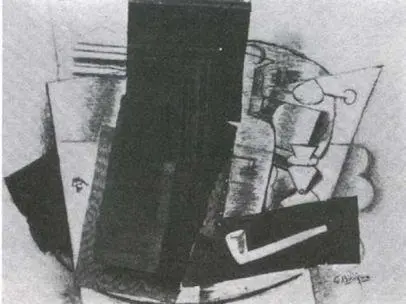
30 Braque. Bottle, Glass, and Pipe. 1913
2. By the materials used. Apart from paper and ink, canvas and paint, the Cubists introduced new techniques and materials. They used stencils for making letters and numbers, they stuck paper, oil-cloth, cardboard, tin, on to their pictures. They imitated house-painters (Braque’s father was a house-painter) by using a ‘comb’ to give a painted illusion of wood-graining, they mixed sand and sawdust with their pigment to give it a special texture, they combined techniques — using, for example, pencil with oil-paint. Such experiments were in themselves modern for two reasons. They challenged the whole bourgeois concept of art as something precious, valuable, and to be prized like jewellery. (That these same works, now insured like jewellery, hang today in bourgeois homes beside Boudins and Ingres drawings is one of the ironies of art history.) They were made from what you could find in any hardware store. The challenge in this was the equivalent of putting a printed pamphlet beside a medieval psalter and demanding: which do you choose — beautiful illumination or literacy? The second way in which these experiments were modern lay in their claim for a new freedom for the artist. The artist now had the right to use any means: according to the demands of his vision, no longer according to the demands of his professional etiquette.

31 Picasso. Portrait of Monsieur Kahnweiler. 1910
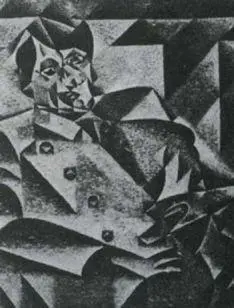
32 Gris. Portrait of Picasso. 1911-12
3. By the way of seeing. This is far more difficult to summarize briefly. The Cubist vision is as complex philosophically as the subjects and materials were deliberately modest. The painters were at great pains to establish the physical presence of what they were representing. And it is here that they are the heirs of Courbet. In the still-lifes this reality of the physical presence is often expressed by the materials used. A newspaper is represented by an actual piece of newsprint. The panelling of a wooden drawer in a table is represented by a piece of imitation wooden-panelled wallpaper. Like Courbet, they hated the conventions that had forgotten their origins: the oil paint in love with itself. Yet they had to use conventions. So they preferred to use the simplest ones which our eyes can still accept innocently: ones which can lead immediately to a vivid awareness of different physical surfaces — wood, paper, stone, metal.
In their figure paintings they approached the problem differently. It was not the presence of the figure as a person of flesh and blood which they now stressed: but the physical complexity of the structure of that figure. At first it may be quite difficult to find the person; and, when found, he or she may have little connexion with the sensuous experience of a body. But the structural arrangement which the body inhabits is made as tangible and precise as the architecture of a town. There is no ambiguity in, as it were, the alphabet used: it is as clear as a printed script; the ambiguity is only in the meaning of some of the words.
This austerity of approach in relation to the figure was at least partly the result of a reaction against excessive talk of the spiritual and soulful. By reducing the body to an organization, comparable with that of a city, they assert the unmetaphysical character of man. They infer (though none of them would have put it in these words) that ‘consciousness is a property of highly organized matter’.
The system of organization which the Cubists used leads us back to Cézanne, their other precursor. Cézanne raised and allowed the question of there being simultaneous view-points, and thereby destroyed for ever in art the possibility of a static view of nature. (Constable’s view, for all its bustling clouds, was nevertheless static.) The Cubists went further. They found the means of making the forms of all objects similar. They achieved this by reducing all forms to a combination of cubes, cylinders, and — later — facets and planes with sharply defined edges. The purpose of this simplification was to be able to construct the most complex view of reality ever attempted in the visual arts. The simplification was very far from being for simplification’s sake. If everything was rendered in the same terms (whether a hand, a violin, or a window) it became possible to paint the interactions between them; their elements became interchangeable. Furthermore, the space in which they all existed could also be rendered in the same terms — but in obverse. (Where the surface of an object was concave, the surface of the space was convex.)
The Cubists created a system by which they could reveal visually the interlocking of phenomena. And thus they created the possibility in art of revealing processes instead of static states of being. Cubism is an art entirely concerned with interaction: the interaction between different aspects: the interaction between structure and movement; the interaction between solids and the space around them; the interaction between the unambiguous signs made on the surface of the picture and the changing reality which they stand in for. It is an art of dynamic liberation from all static categories.
All is possible [wrote Andre Salmon, a Cubist poet], everything is realizable everywhere and with everything.
It is impossible to explain in terms of social and economic history why Cubism began in 1907 and not 1903 or 1910. Sociological explanations of particular works of art or movements in art can never be as precise as that. Indeed they can never be full explanations. They are rather like circumstantial evidence. They can strengthen a case — but should not open one: sometimes they can also destroy a case which has been wrongly opened.
We have already noted the contrast between a feudal Spain and a capitalist Europe: a contrast between the terrible equilibrium of the rack and the ceaseless activity of competition. Spain remained the same. Europe was changing.
Читать дальше
